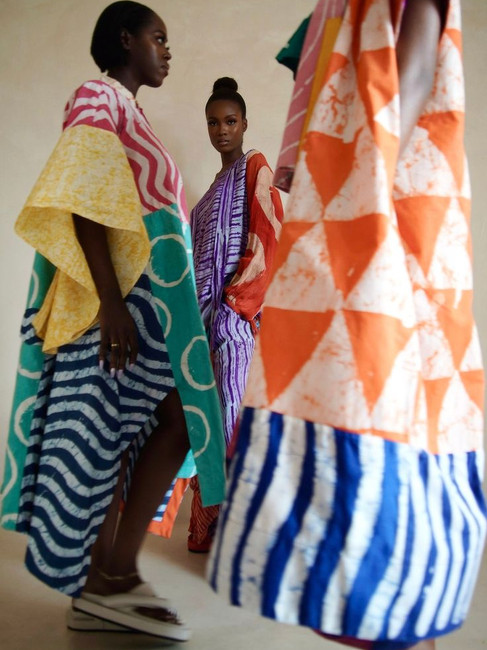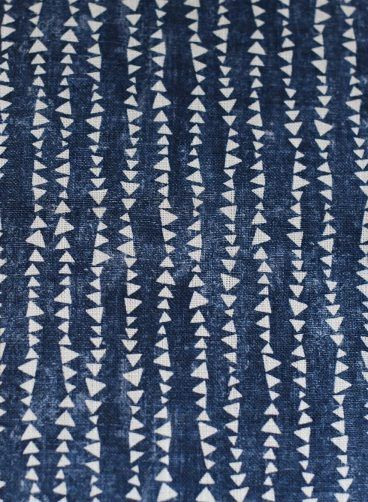Tie-dye charm with a touch of elegance - that's what Shibori patterns bring to your interiors. This Japanese art of resist dyeing has become a global sensation, adorning homes with its organic yet refined appeal.
Let's dive into 10 exciting ways you can incorporate Shibori patterns into your home and elevate your space with a unique touch of artistry.
Shibori Bedding, Designers Guild
The History of Shibori
Shibori, a traditional Japanese dyeing technique, has a rich history that dates back centuries. The art of Shibori involves creating intricate patterns on fabric by binding, stitching, folding, twisting, or compressing it before dyeing. This meticulous process results in unique and beautiful designs that are highly valued in textile art.
Originally, Shibori was used in Japan as a way to decorate and embellish textiles, with each region developing its distinct styles and methods.
Over time, Shibori evolved from a practical craft to a form of artistic expression, with artists experimenting with different techniques and materials to push the boundaries of this ancient art form.
Shibori gained international recognition in the 20th century when Japanese artists showcased their work in exhibitions around the world. Today, Shibori continues to inspire designers and artists globally, with its timeless appeal and intricate patterns captivating audiences everywhere.
What is the origin of the color in Shibori Textiles?
The color in Shibori textiles comes from natural dyes derived from plants, roots, and sometimes even insects. These natural dyes create a wide range of colors, from deep indigos to vibrant reds and earthy browns.
One of the most popular colors associated with Shibori textiles is indigo. Indigo dye has been used for centuries in Japan and other parts of the world to create beautiful blue hues.
Indigo powder can be produced from Indigofera Tinctoria ("indigo plant").
Indigo powder, a natural dye, is derived from the leaves of the Indigofera tinctoria plant, commonly known as the "indigo plant." This plant has been cultivated for centuries due to its rich blue pigment that is extracted through a process of fermentation and oxidation.
Of course there are several varieties of the plant. Read here for the Japanese Indigo Plant.
The intricate method of producing indigo powder involves harvesting the leaves, fermenting them in a water solution, and then allowing the mixture to oxidize to achieve the desired hue.
What is the Process of Dyeing with Indigo?
The use of indigo powder dates back to ancient civilizations where it was valued for its vibrant color and ability to dye various materials such as textiles and clothing.
Today, indigo powder continues to be a popular choice for eco-conscious individuals seeking natural and sustainable alternatives to synthetic dyes. Its deep connection to traditional dyeing practices and its environmentally friendly properties make it a sought-after ingredient in the world of natural dyes.
The process of dyeing with indigo is a labor-intensive one, requiring multiple dips in the dye bath to achieve the desired depth of color. The result is a rich, deep blue that is synonymous with traditional Shibori textiles.
Each Shibori textile is a unique piece of art, with the patterns and colors reflecting the skill and creativity of the artisan who created it.
The process of making Shibori textiles is a meticulous and time-consuming one, requiring patience and precision to achieve the intricate designs that are characteristic of this traditional craft.
So let's see how you can incorporate products that have been lovingly made in your own home.
1. Shibori Bedding
Wrap yourself in cozy elegance with Shibori bedding sets. The gentle swirls and mesmerizing patterns on duvet covers and pillowcases can instantly transform your bedroom into a tranquil oasis.
2. Shibori Wall Art
Make a bold statement with Shibori wall art. Hang framed Shibori fabrics or canvas prints to add a pop of color and texture to your walls. The intricate patterns will turn your blank walls into captivating focal points.

Shibori wall art, Etsy
3. Shibori Throw Pillows
Spruce up your living room with Shibori throw pillows. Mix and match different patterns and colors to create a cozy and chic atmosphere. These pillows are an effortless way to introduce Shibori into your existing decor.
4. Shibori Table Linens
Impress your guests with Shibori table linens. From tablecloths to napkins, these dyed textiles will bring a touch of sophistication to your dining experience. Elevate your table setting with these unique pieces.
5. Shibori Curtains
Enhance your windows with Shibori curtains. The soft, flowing fabrics with delicate Shibori designs can filter light beautifully, creating a serene ambiance in any room. Let nature-inspired Shibori patterns dance across your windows.

Shibiri Curtains, Etsy
6. Shibori Rugs
Step onto luxury with Shibori rugs. These hand-dyed rugs can add warmth and style to any space. Whether you prefer subtle patterns or bold designs, a Shibori rug can tie the room together effortlessly.
7. Shibori Upholstery
Give your furniture a makeover with Shibori upholstery. Reupholster chairs, ottomans, or even headboards with Shibori fabrics to introduce an element of artistry and charm. It's a unique way to breathe new life into your furniture pieces.

8. Shibori Wall Hangings
Explore the world of Shibori wall hangings. These one-of-a-kind textile artworks can enliven any room. Hang them above your bed or sofa for a striking visual impact that showcases the beauty of Shibori patterns.
9. Shibori Ceramic Dinnerware
Add a touch of elegance to your dining table with Shibori ceramic dinnerware. These handcrafted pieces with swirling patterns can elevate your dining experience and make every meal a special occasion.
10. Shibori Home Accessories
From lampshades to planters, there are endless ways to incorporate Shibori patterns into your home decor. Mix and match Shibori accessories to create a cohesive look that reflects your unique style and personality.
Now that you have discovered 10 stylish ways to infuse your home with Shibori patterns, it's time to explore the world of this exquisite dyeing technique. Embrace the artistry and beauty of Shibori in your interiors to create a space that is truly captivating and full of character.
Remember, Shibori is not just a trend; it's a timeless expression of creativity and craftsmanship that will continue to inspire and delight for years to come. Let Shibori patterns weave their magic into your home and watch as your living spaces transform into works of art.
So, what are you waiting for? Dive into the world of Shibori patterns and unleash your creativity in the most stylish way possible!
Want to know more? Look up World Shibori Network (WSN) whose work is to preserve and revitalize Japanese shibori and other heritage textile techniques across the globe through education and community engagement.

Jenny Kakoudakis likes to blog about interiors. She launched award-winning Seasons in Colour in 2014 and the luxury interior design blog All The Pretty Homes in 2024.
When she is not chasing criminals out of the financial system (her day job), she gets creative by redecorating her own home.












Commentaires